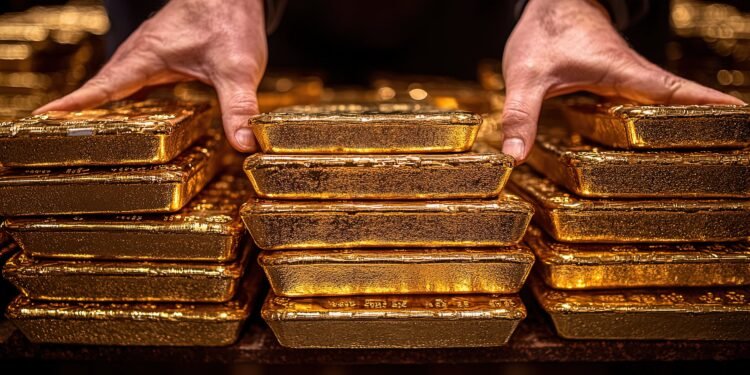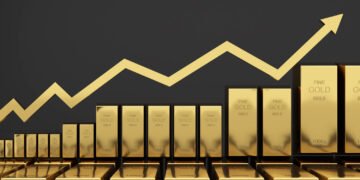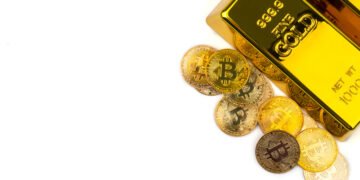The gold market demonstrated its characteristic resilience on Monday morning as prices recovered during early European trading hours, clawing back some of the losses sustained during a steep decline the previous week. The precious metal had tumbled from record highs exceeding $4,300 per ounce, but Monday’s session brought renewed buying interest as traders digested recent developments in global trade tensions and assessed the metal’s long-term outlook. The recovery gained additional support from bullish forecasts by major financial institutions, most notably HSBC, which predicts gold will reach the $5,000 per ounce milestone next year.
Early Trading Shows Promising Recovery
As European markets opened for business on Monday, gold futures contracts demonstrated solid gains, rising 1.3 percent to reach $4,270 per ounce at the time of reporting. Meanwhile, spot gold, which represents immediate delivery rather than future contracts, showed more modest but still positive movement, climbing 0.1 percent to $4,257.15 per ounce. This price action represented a meaningful recovery from Friday’s sharp selloff, though prices remained below the record highs established earlier in the month.
The divergence between futures and spot prices is worth noting, as it often provides insights into market expectations about near-term versus immediate supply and demand dynamics. The stronger performance in the futures market suggests that traders maintain confidence in gold’s medium-term prospects, even as short-term profit-taking and shifting sentiment create volatility in the spot market.
COMEX gold futures for December 2025 delivery showed even more impressive gains in extended trading. According to delayed quote data, the December contract opened at $4,376.40 and traded as high as $4,384.60 during the session, with a low of $4,375.80. By the afternoon at approximately 9:35 Eastern Daylight Time, the December contract was trading at $4,322.80, representing a gain of $109.50 or 2.60 percent for the day. This substantial intraday movement underscores the continued volatility in precious metals markets as investors navigate competing narratives about economic policy, geopolitical tensions, and monetary policy expectations.
Major Financial Institutions Issue Bullish Long-Term Forecasts
The positive momentum in gold prices received reinforcement from bullish forecasts issued by prominent financial institutions. HSBC, one of the world’s largest banking and financial services organizations, released projections indicating that gold’s ongoing bull run could propel prices as high as $5,000 per ounce by 2026. The bank’s analysts cited two primary factors supporting this optimistic outlook: persistent geopolitical risks that continue to drive safe-haven demand, and growing participation from new classes of investors who are increasingly viewing gold as an essential portfolio component.
This forecast from HSBC follows a similar revision by Goldman Sachs earlier in the month. The Wall Street investment banking giant raised its December 2026 gold price forecast to $4,900 per ounce from a previous target of $4,300. Goldman Sachs analysts pointed to strong inflows into Western exchange-traded funds as a key driver of their revised projection. ETFs have become an increasingly popular vehicle for gold investment, allowing investors to gain exposure to gold price movements without the complexities of physical storage and security. The sustained inflows into these products indicate robust institutional and retail investor demand for gold exposure.
Additionally, Goldman Sachs cited likely continued central bank buying as supporting their bullish case. Central banks around the world have been accumulating gold reserves at a historically significant pace in recent years, driven by desires to diversify away from dollar-denominated assets and increase the proportion of gold in their total reserve holdings. This steady institutional demand from central banks provides a fundamental floor of support for gold prices and reduces the likelihood of sustained price declines.
Trade Policy Developments Trigger Friday Selloff
To understand Monday’s recovery, it’s essential to examine the factors that drove Friday’s sharp decline. The precious metal experienced a significant selloff after President Donald Trump signaled a notably softer stance toward Beijing, marking a potential de-escalation in the trade tensions that had been supporting gold’s safe-haven appeal. The president made comments indicating that his proposed 100 percent tariff on Chinese goods would not be sustainable over the long term, suggesting a willingness to pursue more moderate trade policies.
Trump went further, announcing that he would meet with Chinese President Xi Jinping in South Korea within two weeks’ time. The president expressed optimism about the outcome of this diplomatic engagement, stating that he thought “things would be fine with China.” These comments represented a marked shift in tone from the more confrontational rhetoric that had characterized recent weeks and months of trade policy discussions.
President Trump’s explicit statement that “high tariffs on China are not sustainable” sent ripples through financial markets, triggering a rally in equities and other risk assets. When investors perceive reduced geopolitical tensions and improved prospects for global trade, they typically rotate away from safe-haven assets like gold and into higher-risk, higher-return investments such as stocks. This shift in risk appetite explained much of Friday’s decline in gold prices.
The trade policy narrative received additional support from statements by United States Treasury Secretary Scott Bessent, who confirmed that talks with Chinese officials were scheduled to take place during the current week. This confirmation of active diplomatic engagement further reduced concerns about an extended period of trade conflict and contributed to the diminished safe-haven appeal of gold.
Understanding Gold’s Recent Price Drivers
Gold’s remarkable surge in recent months has been driven by a confluence of factors that created an exceptionally supportive environment for safe-haven assets. Heightened geopolitical risks across multiple regions have consistently driven investors toward gold as a store of value and portfolio insurance. These risks have included trade tensions between major economic powers, regional conflicts, and broader concerns about global economic stability.
The extended United States government shutdown has also played a significant role in supporting gold prices. Government shutdowns create uncertainty about fiscal policy implementation, government spending patterns, and the overall functioning of federal institutions. This uncertainty tends to benefit gold, as investors seek assets that are insulated from domestic political dysfunction.
Perhaps most significantly, growing expectations of further Federal Reserve rate cuts have provided substantial support for gold prices. Gold does not generate yield or income, which means it becomes relatively more attractive when interest rates are low or declining. When the Federal Reserve cuts interest rates, it reduces the opportunity cost of holding gold versus interest-bearing assets like bonds. Market participants have been increasingly pricing in the possibility of additional rate cuts as the Federal Reserve responds to evolving economic conditions, and this expectation has translated into sustained buying pressure for gold.
Analysts observing Friday’s price action noted that the magnitude of the decline was amplified by profit-taking after a sustained rally over the previous two months. When gold prices rise substantially over a compressed timeframe, many investors who purchased at lower levels begin to lock in their gains by selling. This profit-taking can accelerate downward price movements, particularly when it coincides with shifts in the fundamental narrative supporting gold prices, as occurred with Trump’s softer stance on China trade policy.
Broader Context for United Kingdom Property Markets
While gold markets captured significant attention, other economic indicators also provided insights into broader economic conditions. Average United Kingdom house asking prices rose by over £1,000 in October, according to recent data. This increase in property prices occurs against the backdrop of a complex economic environment characterized by persistent inflation concerns, elevated interest rates by historical standards, and uncertainty about the trajectory of monetary policy. The resilience in property prices suggests continued underlying demand in the UK housing market, though affordability challenges remain significant for many prospective buyers.
Looking Ahead: Balancing Competing Narratives
As traders and investors assess the outlook for gold prices, they must balance competing narratives. On one hand, potential de-escalation in trade tensions could reduce some of the geopolitical risk premium currently embedded in gold prices. Successful diplomatic engagement between the United States and China could foster improved global trade conditions, potentially reducing demand for safe-haven assets.
On the other hand, the fundamental factors that have supported gold’s bull run remain largely intact. Central banks continue to diversify their reserves toward gold, Western ETF inflows remain strong, and monetary policy expectations continue to favor lower interest rates in developed economies. Additionally, even with potential progress in US-China relations, numerous other geopolitical risks persist globally, from regional conflicts to concerns about currency stability and government debt levels.
The forecasts from major institutions like HSBC and Goldman Sachs, projecting gold prices between $4,900 and $5,000 per ounce by 2026, reflect confidence that these supportive fundamental factors will outweigh any near-term headwinds from improved trade relations. However, the path to these price targets is unlikely to be linear, and investors should expect continued volatility as markets process evolving news on trade policy, monetary policy, and geopolitical developments. Monday’s recovery serves as a reminder of gold’s enduring appeal and the strong underlying demand that continues to support prices even after sharp corrections.
Acknowledgment: This article was written with the help of AI, which also assisted in research, drafting, editing, and formatting this current version







